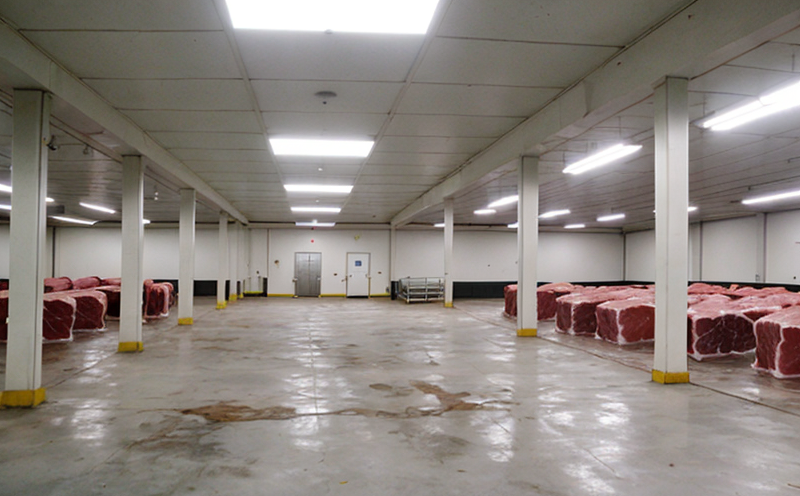Meat processing facility inspection
The inspection of a meat processing facility is crucial to ensuring food safety and hygiene, which directly impacts public health. Compliance with strict regulatory requirements such as FSIS (USDA Food Safety and Inspection Service) guidelines ensures that every step from raw material handling to final product packaging meets the highest standards of quality and safety.
The inspection process involves a thorough evaluation of various aspects including facility design, sanitation practices, staff hygiene protocols, equipment calibration, and waste management systems. This comprehensive approach helps identify potential risks early on, thereby preventing contamination that could lead to recalls or health hazards.
For instance, temperature control during processing stages is critical for preserving the integrity and safety of meat products. Our team uses advanced thermometry tools like digital probes and infrared sensors to measure temperatures accurately throughout each phase of production. By adhering strictly to standards such as ISO 9001 for quality management systems, we ensure consistent adherence to best practices.
In addition to physical inspections, our laboratory utilizes microbiological testing methods that comply with international norms like ASTM E2435 for evaluating pathogen presence. These tests help guarantee the absence of harmful bacteria such as Salmonella and E.coli, which are common concerns in meat processing environments.
The importance of this inspection cannot be overstated; it not only protects consumers but also enhances brand reputation by maintaining a high level of trust among customers. Regular audits assist facilities in identifying areas for improvement continuously, fostering an environment where excellence is the norm rather than exception.
Why It Matters
The significance of meat processing facility inspections extends far beyond mere compliance; it plays a pivotal role in safeguarding public health and maintaining industry standards. Properly executed inspections ensure that all aspects of the production process are up to par, from initial raw material handling through packaging and distribution.
A key factor is the prevention of cross-contamination within facilities. This risk exists because meat processing involves multiple stages where different types of products come into contact with each other. By implementing stringent hygiene measures during inspection, we can minimize these risks significantly. For example, thorough cleaning protocols using appropriate chemicals followed by rigorous disinfection procedures are essential steps in preventing contamination.
Another critical aspect addressed by our inspections is employee training and behavior. Staff play a vital role in maintaining sanitary conditions inside the plant; therefore, continuous education on proper hygiene practices ensures everyone understands their responsibilities fully. This includes regular handwashing, wearing clean uniforms, and handling food safely at all times.
The overall aim of these inspections is to create a safer work environment both for employees and consumers alike while upholding rigorous quality control measures. Through meticulous attention to detail during each phase of production, we help establish trust between producers and their customers, ultimately contributing positively towards public health initiatives globally.
Industry Applications
| Application Area | Description | Standard Compliance |
|---|---|---|
| Raw Material Handling | Evaluation of incoming materials for cleanliness and safety. | ISO 17604 |
| Processing Equipment Calibration | Verification of machinery accuracy to ensure consistent product quality. | ASTM E2865 |
| Packaging Integrity Checks | Assessment of closure effectiveness and seal strength for packaged products. | ISO 11607-2 |
| Waste Management Systems | Analysis of waste disposal methods to prevent environmental contamination. | ISO 14001 |
| Staff Hygiene Protocols | Evaluation of staff behavior regarding personal cleanliness and infection control. | ASTM E2695 |
| Temperature Control Systems | Monitoring temperature settings to maintain optimal conditions during processing. | ISO 17604 |
| Bacteriological Sampling | Collection and analysis of samples for detecting harmful microorganisms. | ASTM E2950 |
| Pest Control Measures | Investigation into effectiveness of pest management strategies within the facility. | ISO 16149 |
Why Choose This Test
Selecting the right inspection services for your meat processing facility is essential to ensure compliance with regulatory requirements and maintain a high standard of food safety. Our specialized team offers comprehensive assessments tailored specifically to meet these needs, providing peace of mind through detailed reports and actionable recommendations.
Our approach combines both visual inspections and laboratory analyses which together offer a holistic view of the entire operation. With expertise spanning various sectors including agriculture and pharmaceuticals, we bring unique insights into best practices that can be applied within your facility.
The benefits extend beyond just compliance; they include enhanced operational efficiency, reduced downtime due to unexpected issues, and improved customer satisfaction levels. By partnering with us, you gain access to cutting-edge technologies and methodologies designed specifically for the meat industry, ensuring long-term success in meeting regulatory expectations.





